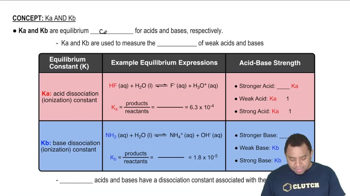Here are the essential concepts you must grasp in order to answer the question correctly.
Acid-Dissociation Constants (Ka)
Acid-dissociation constants (Ka) quantify the strength of an acid in solution, indicating how well it donates protons (H+) to water. A higher Ka value corresponds to a stronger acid, which means it dissociates more completely in solution. Understanding Ka is essential for comparing the basicity of oxyanions, as the conjugate bases of stronger acids are weaker bases.
Recommended video:
Characteristics of Ka and Kb
Oxyanions and Their Basicity
Oxyanions are negatively charged ions that contain oxygen, and their basicity is influenced by the central atom and the number of oxygen atoms. Generally, the more electronegative the central atom or the more oxygen atoms present, the weaker the base. This is due to the stabilization of the negative charge by resonance and the ability of the central atom to withdraw electron density.
Recommended video:
Comparative Analysis of Oxyanions
To arrange oxyanions from strongest to weakest base, one must compare their acid-dissociation constants and the stability of their conjugate acids. By analyzing the Ka values of the corresponding acids, one can infer the relative strength of the oxyanions as bases. This comparative analysis is crucial for determining the order of basicity among the given oxyanions.
Recommended video:




